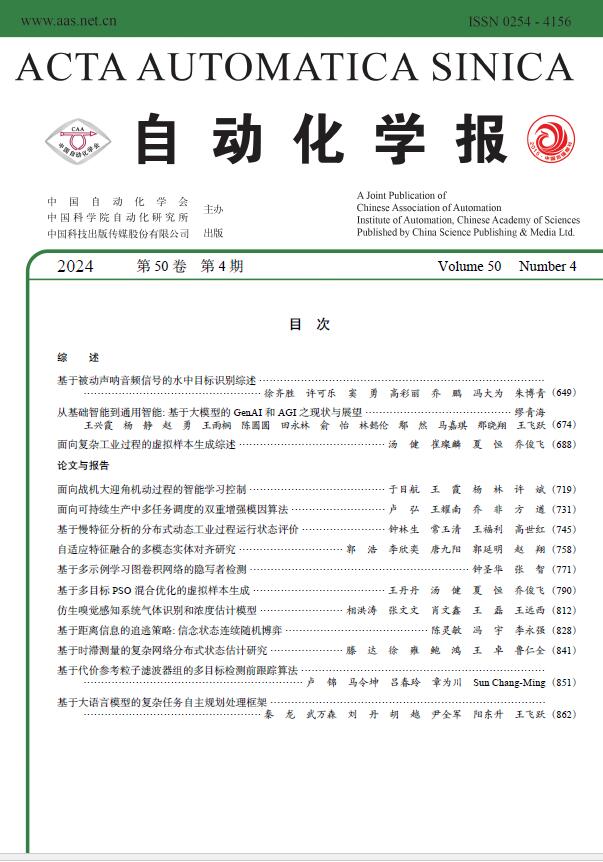机器人操作技能学习方法综述
本文介绍了机器人操作技能学习的主要方法及最新的研究成果.依据对训练数据的使用方式将机器人操作技能学习方法分为基于强化学习的方法、基于示教学习的方法和基于小数据学习的方法,并基于此对近些年的研究成果进行了综述和分析,最后列举了机器人操作技能学习的未来发展方向.
刘乃军, 鲁涛, 蔡莹皓, 王硕. 机器人操作技能学习方法综述. 自动化学报, 2019, 45(3): 458-470.
http://html.rhhz.net/ZDHXBZWB/html/2019-3-458.htm
智能合约:架构及进展
本文致力于以区块链智能合约为研究对象,对已有的研究成果进行全面梳理和系统概述,提出了智能合约的基础架构模型并以此为研究框架阐述了智能合约的运行机制与基础架构,总结了智能合约的研究挑战与进展,介绍了智能合约的技术优势与典型应用领域,讨论了智能合约的发展趋势,以期为智能合约的后续研究提供参考.
欧阳丽炜, 王帅, 袁勇, 倪晓春, 王飞跃. 智能合约:架构及进展. 自动化学报, 2019, 45(3): 445-457.
http://html.rhhz.net/ZDHXBZWB/html/2019-3-445.htm
工业网络系统的感知-传输-控制一体化:挑战和进展
本文简述了工业网络系统的内涵和主要特征,分析了感知-传输-控制一体化面临的挑战和关键问题;综述了分布式状态感知、适变传输、协同控制等关键技术的研究进展;对工业网络系统的未来研究方向和潜在应用前景进行了总结和展望.
关新平, 陈彩莲, 杨博, 华长春, 吕玲, 朱善迎. 工业网络系统的感知-传输-控制一体化:挑战和进展. 自动化学报, 2019, 45(1): 25-36.
http://html.rhhz.net/ZDHXBZWB/html/2019-1-25.htm
RGB-D行为识别研究进展及展望
本文系统地综述了RGB-D行为识别领域的研究进展和展望.首先,对近年来RGB-D行为识别领域中常用的公共数据集进行简要的介绍;同时也系统地介绍了多模态RGB-D行为识别研究领域的典型模型和最新进展,其中包括卷积神经网络和循环神经网络等深度学习技术在RGB-D行为识别的应用;最后,在三个公共RGB-D行为数据库上对现有方法的优缺点进行了比较和分析,并对未来的相关研究进行了展望.
胡建芳, 王熊辉, 郑伟诗, 赖剑煌. RGB-D行为识别研究进展及展望. 自动化学报, 2019, 45(5): 829-840.
http://html.rhhz.net/ZDHXBZWB/html/2019-5-829.htm
信息物理系统技术综述
本文对CPS进行了简要介绍,根据技术的应用特点对CPS的现有研究成果进行了分类,综述了各个研究方向的意义和研究进展,给出了CPS的两个典型实际案例,探讨了CPS研究中亟待解决的问题以及未来可能的研究方向.
李洪阳, 魏慕恒, 黄洁, 邱伯华, 赵晔, 骆文城, 何晓, 何潇. 信息物理系统技术综述. 自动化学报, 2019, 45(1): 37-50.
http://html.rhhz.net/ZDHXBZWB/html/2019-1-37.htm
鸡尾酒会问题与相关听觉模型的研究现状与展望
本文综述了鸡尾酒会问题相关听觉模型研究的现状与展望.在简要介绍了听觉机理的相关研究,并概括了解决鸡尾酒会问题的多说话人语音分离相关计算模型之后,本文还讨论了受听觉认知机理启发的听觉注意建模方法,认为融入声纹记忆和注意选择的听觉模型在复杂的听觉环境下具有更好的适应性.之后,本文简单回顾了近期的多说话人语音识别模型.最后,本文讨论了目前各类计算模型用于处理鸡尾酒会问题时遇到的困难和挑战,并对未来的研究方向进行了展望.
黄雅婷, 石晶, 许家铭, 徐波. 鸡尾酒会问题与相关听觉模型的研究现状与展望. 自动化学报, 2019, 45(2): 234-251.
http://html.rhhz.net/ZDHXBZWB/html/2019-2-234.htm
信息物理融合系统综合安全威胁与防御研究
本文介绍了CPS的概念与安全现状,给出了CPS综合安全的定义;在对现有安全事件进行分析的基础上,提出了CPS的综合安全威胁模型;从时间关联性和空间关联性的角度,对现有CPS攻击和防御方法进行了分类和总结,并探讨CPS综合安全的研究方向.
刘烃, 田决, 王稼舟, 吴宏宇, 孙利民, 周亚东, 沈超, 管晓宏. 信息物理融合系统综合安全威胁与防御研究. 自动化学报, 2019, 45(1): 5-24.
http://html.rhhz.net/ZDHXBZWB/html/2019-1-5.htm
Networked Control Systems: A Survey of Trends and Techniques
Networked control systems are spatially distributed systems in which the communication between sensors, actuators, and controllers occurs through a shared band-limited digital communication network. Several advantages of the network architectures include reduced system wiring, plug and play devices, increased system agility, and ease of system diagnosis and maintenance. Consequently, networked control is the current trend for industrial automation and has ever-increasing applications in a wide range of areas, such as smart grids, manufacturing systems, process control, automobiles, automated highway systems, and unmanned aerial vehicles. The modelling, analysis, and control of networked control systems have received considerable attention in the last two decades. The ‘control over networks’ is one of the key research directions for networked control systems. This paper aims at presenting a survey of trends and techniques in networked control systems from the perspective of ‘control over networks’, providing a snapshot of five control issues: sampleddata control, quantization control, networked control, eventtriggered control, and security control. Some challenging issues are suggested to direct the future research.
X.-M. Zhang, Q.-L. Han, X. H. Ge, D. Ding, L. Ding, D. Yue, and C. Peng, “Networked control systems: a survey of trends and techniques,” IEEE/CAA J. Autom. Sinica, doi: 10.1109/JAS.2019.1911651
http://www.ieee-jas.org/article/id/69cc1ddf-cada-4795-83c9-7635c816ca15?viewType=HTML&pageType=en
An Overview and Perspectives On Bidirectional Intelligence: Lmser Duality, Double IA Harmony, and Causal Computation
Advances on bidirectional intelligence are overviewed along three threads, with extensions and new perspectives. The first thread is about bidirectional learning architecture, exploring five dualities that enable Lmser six cognitive functions and provide new perspectives on which a lot of extensions and particularlly flexible Lmser are proposed. Interestingly, either or two of these dualities actually takes an important role in recent models such as U-net, ResNet, and DenseNet. The second thread is about bidirectional learning principles unified by best yIng-yAng (IA) harmony in BYY system. After getting insights on deep bidirectional learning from a bird-viewing on existing typical learning principles from one or both of the inward and outward directions, maximum likelihood, variational principle, and several other learning principles are summarised as exemplars of the BYY learning, with new perspectives on advanced topics. The third thread further proceeds to deep bidirectional intelligence, driven by long term dynamics (LTD) for parameter learning and short term dynamics (STD) for image thinking and rational thinking in harmony. Image thinking deals with information flow of continuously valued arrays and especially image sequence, as if thinking was displayed in the real world, exemplified by the flow from inward encoding/cognition to outward reconstruction/transformation performed in Lmser learning and BYY learning. In contrast, rational thinking handles symbolic strings or discretely valued vectors, performing uncertainty reasoning and problem solving. In particular, a general thesis is proposed for bidirectional intelligence, featured by BYY intelligence potential theory (BYY-IPT) and nine essential dualities in architecture, fundamentals, and implementation, respectively. Then, problems of combinatorial solving and uncertainty reasoning are investigated from this BYY IPT perspective. First, variants and extensions are suggested for AlphaGoZero like searching tasks, such as traveling salesman problem (TSP) and attributed graph matching (AGM) that are turned into Go like problems with help of a feature enrichment technique. Second, reasoning activities are summarized under guidance of BYY IPT from the aspects of constraint satisfaction, uncertainty propagation, and path or tree searching. Particularly, causal potential theory is proposed for discovering causal direction, with two roads developed for its implementation.
L. Xu, “An overview and perspectives on bidirectional intelligence: Lmser duality, double IA harmony, and causal computation,” IEEE/CAA J. Autom. Sinica, vol. 6, no. 4, pp. 865–893, Jul. 2019.
http://www.ieee-jas.org/article/doi/10.1109/JAS.2019.1911603?viewType=HTML&pageType=en
A Survey of Multi-robot Regular and Adversarial Patrolling
Multi-robot systems can be applied to patrol a concerned environment for security purposes. According to different goals, this work reviews the existing researches in a multi-robot patrolling field from the perspectives of regular and adversarial patrolling. Regular patrolling requires robots to visit important locations as frequently as possible and a series of deterministic strategies are proposed, while adversarial one focuses on unpredictable robots’ moving patterns to maximize adversary detection probability. Under each category, a systematic survey is done including problem statements and modeling, patrolling objectives and evaluation criteria, and representative patrolling strategies and approaches. Existing problems and open questions are presented accordingly.
L. Huang, M. C. Zhou, K. R. Hao, and E. Hou, “A survey of multi-robot regular and adversarial patrolling,” IEEE/CAA J. Autom. Sinica, vol. 6, no. 4, pp. 894–903, Jul. 2019
http://www.ieee-jas.org/article/doi/10.1109/JAS.2019.1911537?pageType=en
The Need for Fuzzy AI
Artificial intelligence (AI) is once again a topic of huge interest for computer scientists around the world. Whilst advances in the capability of machines are being made all around the world at an incredible rate, there is also increasing focus on the need for computerised systems to be able to explain their decisions, at least to some degree. It is also clear that data and knowledge in the real world are characterised by uncertainty. Fuzzy systems can provide decision support, which both handle uncertainty and have explicit representations of uncertain knowledge and inference processes. However, it is not yet clear how any decision support systems, including those featuring fuzzy methods, should be evaluated as to whether their use is permitted. This paper presents a conceptual framework of indistinguishability as the key component of the evaluation of computerised decision support systems. Case studies are presented in which it has been clearly demonstrated that human expert performance is less than perfect, together with techniques that may enable fuzzy systems to emulate human-level performance including variability. In conclusion, this paper argues for the need for " fuzzy AI” in two senses: (i) the need for fuzzy methodologies (in the technical sense of Zadeh’s fuzzy sets and systems) as knowledge-based systems to represent and reason with uncertainty; and (ii) the need for fuzziness (in the non-technical sense) with an acceptance of imperfect performance in evaluating AI systems.
J. M. Garibaldi, “The need for fuzzy AI,” IEEE/CAA J. Autom. Sinica, vol. 6, no. 3, pp. 610–622, May 2019.
http://www.ieee-jas.org/en/article/doi/10.1109/JAS.2019.1911465
Advances in Control Technologies for Wastewater Treatment Processes:Status, Challenges, and Perspectives
This paper presents a thorough review of control technologies that have been applied to wastewater treatment processes in the environmental engineering regime in the past four decades. It aims to provide a comprehensive technological review for both water engineering professionals and control specialists, giving rise to a suite of up-to-date pathways to impact this field in light of the classified technology hubs. The assessment was conducted with respect to linear control, linearizing control, nonlinear control, and artificial intelligence-based control. The application domain of each technology hub was summarized into a set of comparative tables for a holistic assessment. Challenges and perspectives were offered to these field engineers to help orient their future endeavor.
A. Iratni and N.-B. Chang, “Advances in control technologies for wastewater treatment processes: status, challenges, and perspectives,” IEEE/CAA J. Autom. Sinica, vol. 6, no. 2, pp. 337-363, Mar. 2019.
http://www.ieee-jas.org/en/article/doi/10.1109/JAS.2019.1911372
Feature-Based Aggregation and Deep Reinforcement Learning: A Survey and Some New Implementations
In this paper we discuss policy iteration methods for approximate solution of a finite-state discounted Markov decision problem, with a focus on feature-based aggregation methods and their connection with deep reinforcement learning schemes. We introduce features of the states of the original problem, and we formulate a smaller "aggregate" Markov decision problem, whose states relate to the features. We discuss properties and possible implementations of this type of aggregation, including a new approach to approximate policy iteration. In this approach the policy improvement operation combines feature-based aggregation with feature construction using deep neural networks or other calculations. We argue that the cost function of a policy may be approximated much more accurately by the nonlinear function of the features provided by aggregation, than by the linear function of the features provided by neural networkbased reinforcement learning, thereby potentially leading to more effective policy improvement.
D. P. Bertsekas, “Feature-based aggregation and deep reinforcement learning: a survey and some new implementations,” IEEE/CAA J. Autom. Sinica, vol. 6, no. 1, pp. 1-31, Jan. 2019.
http://www.ieee-jas.org/en/article/doi/10.1109/JAS.2018.7511249














